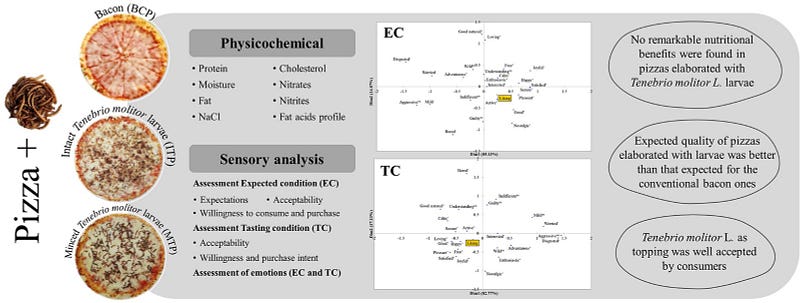Exploring the Surprising Appeal of Mealworm Pizza
Written on
Chapter 1: Introduction to Mealworm Pizza
Recent research has unveiled that pizza topped with mealworm larvae isn't as unappealing as many might assume — a significant revelation indeed. The study, aptly titled "Newbie consumers try pizzas in which bacon is replaced by Tenebrio molitor L. larvae: Not as healthy as expected and not as terrible as they thought," investigates consumer reactions to this unconventional topping.
Conducted by the Federal University of Paraiba in Brazil and the University of Extremadura in Spain, the study compared consumer expectations and responses to pizzas adorned with mealworms, both whole and minced, against a control group of bacon-topped pizzas.
This research is not just entertaining but holds crucial implications for the acceptance of insect protein as a viable human food source, potentially aiding efforts against climate change and food insecurity.

Consumer Reactions and Preferences
The primary aim of the study was to investigate how consumers perceive mealworm pizza compared to the traditional bacon option. Researchers recorded emotional responses from participants before and after tasting each variety of pizza.
Initially, bacon pizza received higher ratings for sensory appeal and purchase intention. However, post-tasting feedback showed an improvement in attitudes towards mealworm pizza, while sentiments towards bacon remained unchanged. Participants reported fewer negative emotions associated with the insect-based pizza after sampling it.
The study's authors propose that marketing strategies highlighting the adventurous aspects of consuming edible insects could effectively alleviate consumer hesitance.
Section 1.1: Nutritional Insights
Unfortunately, if you were hoping for mealworm pizza to emerge as a healthier alternative to bacon, the study presents some disappointing news. The nutritional analysis revealed that the mealworm topping offered no distinct advantages over bacon regarding macronutrient content.

The findings indicate that presenting mealworm protein as a healthier substitute for traditional meats may be misleading, particularly regarding the specific pizza examined in this study. Interestingly, even without any prior suggestion of health benefits, participants initially believed that mealworm pizzas would be more nutritious.
Chapter 2: The Future of Insect-Based Foods
Despite the humorous headline and minor ick-factor, this research addresses a vital question: how can we make insect-based foods more appealing to the public? This inquiry is crucial, as insect protein possesses multiple advantages over conventional meat sources.
Most importantly, insect-based foods could play a significant role in combating climate change. They represent a far more sustainable option than traditional meat production, as it generates considerably fewer greenhouse gas emissions and requires less land for the same amount of edible protein.
Moreover, insect proteins can be more affordable, easier to cultivate, and denser in nutrients compared to other meat options, potentially aiding efforts to alleviate poverty and food insecurity. However, several obstacles must be overcome to reap these benefits, including shifting consumer attitudes and navigating legal restrictions that currently impede the adoption of insects as a food source.
Would You Try Mealworm Pizza?
Personally, I would be quite open to sampling mealworm pizza, especially with the prospect of it being flavored like bacon. Like the study participants, I would likely prefer the minced mealworms over whole ones.
What about you? Would you consider trying mealworm pizza if it tasted similar to bacon and offered environmental benefits? Share your thoughts in the comments!
Jonathan covers topics related to startups, software engineering, and health & science. If you appreciate this article, consider joining Medium to support Jonathan and countless other writers.